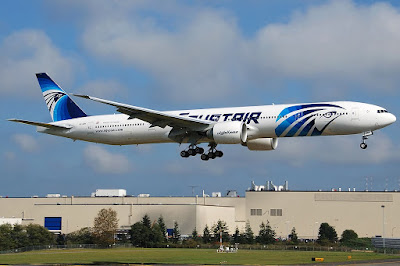EgyptAir flight MS804 disappeared over the eastern Mediterranean Sea while flying overnight from Paris to Cairo. The Airbus A320 had 66 passengers and crew on board.
Search and rescue teams from Egypt and Greece have gone to the last recorded location.
When and where did the plane disappear?
EgyptAir said Flight MS804 departed Paris Charles de Gaulle Airport at 23:09 Paris time (21:09 GMT) on Wednesday. It had been scheduled to land at Cairo International Airport at 03:15 Cairo time (01:15 GMT) on Thursday.
Where missing EgyptAir plane had been in past 24 hours
The plane lost contact with radar at 02:30 Cairo time (00:30 GMT), when it was about 280km (174 miles) from the Egyptian coast - just inside Egyptian airspace - at an altitude of 11,000m (37,000ft).
Did the plane crash into the sea?
Egyptian Prime Minister Sherif Ismail told reporters at Cairo airport on Thursday morning that it was too early to say what had happened to the plane.
He spoke after EgyptAir said in Arabic on its Twitter page that the plane had sent an emergency signal at 04:26 Cairo time (02:26 GMT) - possibly from an emergency beacon - two hours after it had disappeared from radar screens.
The Egyptian military subsequently issued a statement denying that any distress calls had been received.
The AFP news agency meanwhile quoted a Greek aviation source as saying the plane had disappeared off Greek radar screens at 00:29 GMT and crashed into the sea around 240km (130 nautical miles) off the Greek island of Karpathos.
The head of the Hellenic Civil Aviation Authority, Kostas Litzerakis, said Greek air traffic controllers had spoken to the pilot as the plane flew over the island of Kea and that he had reported no problems.
The controllers had tried to make contact with the pilot 16km (10 miles) before the plane exited Greek airspace, but he had not responded, Mr Litzerakis added. The plane vanished from their radars shortly after entering Egyptian airspace.
A Greek defence ministry source also told the Reuters news agency that Greek authorities were investigating an account from the captain of a merchant ship who said he had seen a "flame in the sky" south of Karpathos.
Could it have been terrorism?
Egypt's prime minister said it was too early to say whether the disappearance was the result of a major technical failure or a terrorist attack. "We cannot rule anything out," he stressed.
That can only be ascertained when the plane is located and the cockpit voice and data recorders, commonly known as the black boxes, are recovered.
However, an Airbus A321 operated by Russia's Metrojet was brought down by a bomb over Egypt's Sinai peninsula on 31 October 2015, killing all 224 people on board. A local affiliate of the jihadist militant group Islamic State (IS) said it had smuggled a device on board.
IS has vowed to continue targeting the Egyptian state and Westerners who visit Egypt.
An EgyptAir plane was also hijacked and diverted to Cyprus in March. An Egyptian man described by Cypriot authorities as "psychologically unstable" is in custody.
Who was on board?
EgyptAir said there were 56 passengers, including one child and two infants, and 10 crew members on board.
They comprised 30 Egyptians, 15 French, two Iraqis, one Briton, one Kuwaiti, one Saudi, one Sudanese, one Chadian, one Portuguese, one Belgian, one Algerian and one Canadian.
Egypt's state-run al-Ahram newspaper cited sources as identifying the pilot as Captain Mohamed Shokeir. EgyptAir said he had 6,275 hours of flying experience, including 2,101 hours on the A320, while the first officer had 2,766 hours.
What do we know about the plane?
Airbus said the aircraft involved, an A320-232 registered as SU-GCC, was delivered to EgyptAir from the production line in November 2003.
The aircraft had accumulated approximately 48,000 flight hours. It was powered by two IAE engines.
The plane tracking website, Flightradar24, reported that on Wednesday the plane had flown from Asmara, in Eritrea, to Cairo, then on to Tunis, in Tunisia, before heading, via Cairo, to Paris.
A320s typically seat 150 passengers in a two-class cabin, or up to 180 in a high-density layout. They have a range of up to 6,480km (3,500 nautical miles).
The aircraft family first entered service in 1988. At the end of April 2016 more than 6,700 A320s were in operation worldwide, according to Airbus. To date, the entire fleet has accumulated almost 180 million flight hours in over 98 million flights.

Comments
Post a Comment